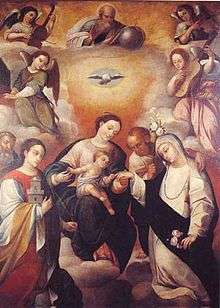Gregorio Vasquez de Arce y Ceballos
| Gregorio Vásquez | |
|---|---|
 | |
| Born |
Gregorio Vasquez de Arce y Ceballos May 9, 1638 Bogotá, Colombia |
| Died |
August 6, 1711 (aged 73) Bogotá |
| Nationality | Colombian |
| Known for | Painting |
| Notable work |
(The Final Judgement) (1673), The Immaculate Conception (1697) |
| Movement | Baroque |
Gregorio Vasquez de Arce y Ceballos (May 9, 1638 – August 6, 1711), commonly referred to as Gregorio Vasquez, was a Colombian painter, including the Quitenian Miguel de Santiago, was one of the leading artist in the Latin American Baroque movement, which extended from the mid 17th to the late 18th century in the Viceroyalty of New Granada. Most of the artwork of Vázquez depicts the life of Christ, Virgin Mary, the Saints and scenes of the New Testament.
Vázquez was born in Bogotá, in a criollo family of Andalusian origin. The Vasquez family emigrated from Seville, Spain in the 16th century. He received art classes in the St Bartolome College and as apprentice of the painter Baltasar de Vargas Figueroa.
In 1701 Vasquez went to jail due to his involvement with the kidnapping of Doña María Teresa de Orgaz from the Santa Clara Convent. When he left the jail, he was in deep poverty and went insane, never painting again. Finally, he died in 1711 in Bogotá. In 1863 the Colombian government placed a conmemorative plaque in the house where Vasquez was born and died (Calle 11 No. 3-99).
References
- Brief biography @ Colarte
